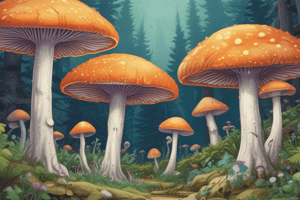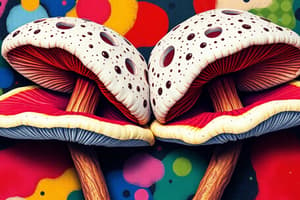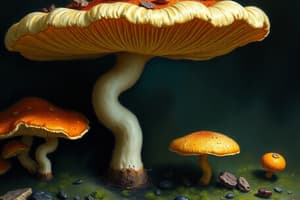Podcast
Questions and Answers
What characterizes asexual reproduction in animals?
What characterizes asexual reproduction in animals?
- Involves two parents contributing genes.
- Requires fertilization of gametes.
- Results in genetically modified offspring.
- Produces offspring that are clones of the parent. (correct)
Which process involves the development of a new organism from a bud on the parent organism?
Which process involves the development of a new organism from a bud on the parent organism?
- Fragmentation
- Sporulation
- Binary fission
- Budding (correct)
What type of nutrition do fungi utilize to obtain their nourishment?
What type of nutrition do fungi utilize to obtain their nourishment?
- Filter feeding
- Photosynthesis
- Chemosynthesis
- Absorbing small food molecules (correct)
Which of the following phyla of fungi is represented by common bread mold?
Which of the following phyla of fungi is represented by common bread mold?
Why are mushrooms classified under the phylum Basidiomycota considered important?
Why are mushrooms classified under the phylum Basidiomycota considered important?
What is the name of the father of the Punnett square?
What is the name of the father of the Punnett square?
Sexual reproduction involves the union of gametes.
Sexual reproduction involves the union of gametes.
In asexual reproduction, the offspring has the exact copy of the genes.
In asexual reproduction, the offspring has the exact copy of the genes.
What is the other name for asexual reproduction?
What is the other name for asexual reproduction?
What is the name given to the new organism that develops from an outgrowth or bud due to cell division at a particular site?
What is the name given to the new organism that develops from an outgrowth or bud due to cell division at a particular site?
What is the term for a form of asexual reproduction in which an unfertilized egg develops into an adult?
What is the term for a form of asexual reproduction in which an unfertilized egg develops into an adult?
What kind of eggs are produced by females in parthenogenesis?
What kind of eggs are produced by females in parthenogenesis?
What is the opposite of unfertilized eggs in parthenogenesis?
What is the opposite of unfertilized eggs in parthenogenesis?
What type of asexual reproduction involves the separation of the body into two new bodies?
What type of asexual reproduction involves the separation of the body into two new bodies?
In binary fission, the organism duplicates it's genetic material and then divides into two parts.
In binary fission, the organism duplicates it's genetic material and then divides into two parts.
Fungi are heterotrophs.
Fungi are heterotrophs.
How do fungi obtain nourishment?
How do fungi obtain nourishment?
What is the scientific name for the common bread mold?
What is the scientific name for the common bread mold?
How do molds reproduce asexually?
How do molds reproduce asexually?
What is meant by the term Phylum?
What is meant by the term Phylum?
What are mushrooms classified as?
What are mushrooms classified as?
Many of the mushrooms are edible.
Many of the mushrooms are edible.
Mushrooms are an example of a fungus that belongs to the phylum Ascomycota.
Mushrooms are an example of a fungus that belongs to the phylum Ascomycota.
Flashcards
Asexual Reproduction in Animals
Asexual Reproduction in Animals
Reproduction where offspring comes from a single parent and is genetically identical.
Budding (Blastogenesis)
Budding (Blastogenesis)
A form of asexual reproduction where a new organism develops from an outgrowth (bud) on the parent.
Zygomycota Spores
Zygomycota Spores
Asexual reproduction method in Zygomycota fungi.
Fungi Heterotrophs
Fungi Heterotrophs
Signup and view all the flashcards
Basidiomycota Fungi
Basidiomycota Fungi
Signup and view all the flashcards
External Fertilization
External Fertilization
Signup and view all the flashcards
Internal Fertilization
Internal Fertilization
Signup and view all the flashcards
Timed Release of Gametes
Timed Release of Gametes
Signup and view all the flashcards
Gametes Protection
Gametes Protection
Signup and view all the flashcards
Pathway Protection
Pathway Protection
Signup and view all the flashcards
Sperm Mobility
Sperm Mobility
Signup and view all the flashcards
Estrous Cycles
Estrous Cycles
Signup and view all the flashcards
Viviparous
Viviparous
Signup and view all the flashcards
Ovoviviparous
Ovoviviparous
Signup and view all the flashcards
What is the difference between viviparous and ovoviviparous reproduction?
What is the difference between viviparous and ovoviviparous reproduction?
Signup and view all the flashcards
Study Notes
Asexual Reproduction
- Offspring comes from a single parent
- Exact copy of parent's genes
- Does not involve the union of gametes (sperm and egg)
- Offspring is similar or identical to parent
- Very common in plants; less common in animals
Budding (Blastogenesis)
- New organism develops from an outgrowth or bud
- Cell division at specific site
- Bud forms a small group of cells on the side of parent
Kingdom Fungi
- Heterotrophic: obtain nourishment by absorbing small food molecules
Phylum Zygomycota
- Example: Rhizopus (common bread mold)
- Asexual reproduction by releasing spores from sporangia
Phylum Basidiomycota
- Example: Mushrooms
- Important group; many are edible
Phylum Ascomycota
- Not further detailed in the image
Studying That Suits You
Use AI to generate personalized quizzes and flashcards to suit your learning preferences.





